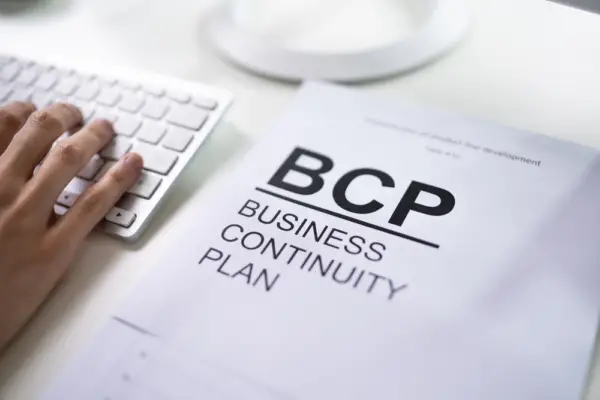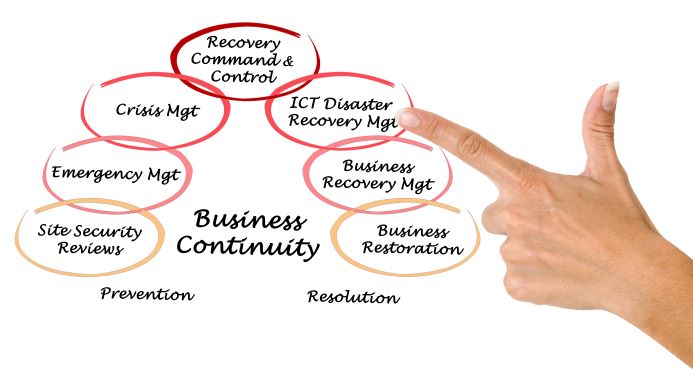Building a business continuity plan (BCP) involves creating a system of prevention and recovery from potential threats to a company. The plan ensures that personnel and assets are protected and can function quickly in a disaster. Some guidelines include the following:-
Business Impact Analysis: The first step is conducting a business impact analysis to identify time-sensitive functions and related resources. This involves interviewing personnel and making detailed process maps to understand the potential impact of disruptions.
Risk Assessment: Identify potential risks and threats, and analyze their likelihood and potential impacts on your business. This could range from natural disasters to cyber-attacks to a global pandemic.
Recovery Strategy: Identify strategies to recover key business functions based on your risk assessment and business impact analysis. This may involve setting up alternate work sites, sourcing alternative suppliers, outsourcing to third parties, or using work-from-home arrangements.
Plan Development: Develop your business continuity plan. This should include clear steps on what to do, who to contact, and how to keep the business operating during various disaster scenarios.
Incident Response: Plan how you will respond in the immediate aftermath of an incident. This could include evacuation plans, safety measures, and communication strategies to keep employees and customers informed.
Training and Testing: Train your employees on the plan and their individual responsibilities. Regular testing and drills can help ensure that your plan is effective and that employees are prepared.
Maintenance: Regularly review and update your plan. As your business grows and changes, your BCP should evolve too. Additionally, real-world events may provide valuable lessons that you can use to improve your plan.
A business continuity plan covers all aspects of an organization, including processes, assets, human resources, partners, and more. It is not the same as a disaster recovery plan focusing solely on IT infrastructure.
A lack of a plan can result in a longer recovery time or even going out of business.
This article will teach readers how to build a successful business continuity plan. The article will provide examples of potential risks, how to prioritize them, and how to test and implement the plan effectively.
Using these steps, organizations can ensure that they are prepared for any disaster and can continue to operate even in the face of adversity.

Assess Risks
The first step in building a business continuity plan is identifying potential risks that could significantly impact your business operations. These risks can include natural disasters, cyberattacks, supply chain disruptions, and even pandemics like COVID-19. It’s important to consider internal and external risks, such as losing key personnel or failing a critical system.
Once you’ve identified potential risks, the next step is to prioritize them based on their potential impact on your business. This involves assessing the likelihood of each risk occurring and the severity of its potential impact. For example, a cyberattack may be less likely than a natural disaster, but its impact on business operations could be much more severe.
To assess risks effectively, involving key stakeholders from across your organization is important. This can include employees from different departments, external vendors, and even customers.
Prioritize Risks
Identifying potential risks and prioritizing them is crucial for ensuring the survival of your organization in the face of unexpected events. Once you’ve identified the potential risks, it’s important to prioritize them based on their potential impact on your business. This will help you allocate your resources and focus on the risks most likely to cause significant damage to your organization.
To prioritize risks, you must consider several factors, such as the likelihood of the risk occurring, the potential impact on your business, and the resources required to address it. For example, a risk with a high probability of occurring but a low impact on your business may not be as high of a priority as a risk with a lower probability of occurring but a higher impact on your business.
Additionally, risks that require significant resources to address may need to be prioritized higher than risks that can be addressed more easily.
Once you have prioritized your risks, you can start developing a plan to address them. This plan should include specific actions that you can take to mitigate the risks and a timeline for when these actions should be taken.

Develop Plans
Once you’ve prioritized your risks, it’s time to start developing plans to address them, so you can be prepared for unexpected events that may impact your e-commerce business. This step involves creating a detailed document outlining the steps to take in a crisis.
The plan should include emergency contact information, essential business functions, the roles and responsibilities of employees, and procedures for restoring critical systems and data.
To develop a comprehensive continuity plan, it’s essential to involve all stakeholders, including employees, suppliers, and customers. Each department should have its own continuity plan that addresses its unique needs and requirements.
For instance, the IT department should have a plan that outlines the procedures for restoring the company’s IT infrastructure. In contrast, the HR department should have a plan that outlines the procedures for managing employee safety and welfare.
It must be tested regularly to ensure that your business continuity plan is effective. This involves running simulations of various crisis scenarios to identify any weaknesses in the plan. Testing should be done at least annually, and the plan should be updated as needed to reflect changes in the business environment.
Using and testing a comprehensive business continuity plan, you can ensure that your e-commerce business is prepared to weather any crisis that may come its way.
| Key Elements of a Business Continuity Plan | Description |
|---|---|
| Emergency Contact Information | A list of emergency contacts for employees, suppliers, and customers |
| Essential Business Functions | A list of critical business functions and the procedures for restoring them |
| Roles and Responsibilities | A list of employees and their roles and responsibilities during a crisis |
| Procedures for Restoring Critical Systems and Data | A step-by-step guide for restoring critical systems and data |
| Testing Procedures | A plan for testing the continuity plan and identifying any weaknesses |
| Plan Maintenance | A procedure for updating the plan as needed to reflect changes in the business environment |
Test Effectiveness
To ensure your preparations are effective, you should regularly test your plan and identify any weaknesses. Testing can take various forms, including tabletop exercises, structured walk-throughs, and simulations.
Each testing phase should include new employees to ensure they’re familiar with the plan and know what to do in an emergency. Testing the plan should be done annually to ensure its effectiveness. This will allow you to identify any areas of weakness and make necessary improvements.
It’s also essential to update the plan annually to reflect organisational changes, such as new employees, process changes, or new technologies. Testing and updating the plan will help ensure your organization is prepared for unexpected events.
It will also give you peace of mind, knowing that you have a plan to minimise any disruptions to your business. Regular testing and updating your plan ensures that your organization is well-prepared to handle any emergency that may arise.
Continuously Review and Update
As you strive to maintain a resilient organization, it’s crucial to continuously review and update your preparedness strategies, ensuring they remain relevant and effective in the face of ever-evolving risks and challenges.
This means regularly assessing and analyzing your business continuity plan to identify gaps or areas needing improvement. As new threats emerge, it’s important to update your plan accordingly and ensure all stakeholders know of any changes.
One way to ensure your plan remains effective is to conduct regular testing and drills. This will allow you to identify any weaknesses in your plan and make any necessary adjustments. It also provides an opportunity to train and educate employees on their roles and responsibilities in an emergency.
Regularly testing and refining your plan can increase the likelihood of a successful response and minimize the impact of any disruptions.
In addition to testing and drills, it’s important to solicit feedback from employees and stakeholders and incorporate any lessons learned from previous incidents. This will help ensure your plan is comprehensive and addresses all potential risks and challenges.
Using reviews and updates to your business continuity plan, you can maintain a state of readiness and increase your organisation’s resilience in unexpected events.
Frequently Asked Questions
What are some common mistakes to avoid when developing a business continuity plan?
When developing a business continuity plan, common mistakes to avoid include not involving senior management, failing to update the plan annually, focusing solely on IT infrastructure, and neglecting to test the plan regularly with new employees.
How can a business ensure that all employees know the plan and how to react in an emergency?
To ensure all employees know the plan and how to react in an emergency, businesses should conduct plan distribution and training, incorporate staff feedback, and have management promote user awareness. Testing should include new employees and the plan should be updated annually.
What resources are available for businesses to use when preparing for unexpected events?
Businesses can prepare for unexpected events by utilizing resources such as PrepareMyBusiness.org, Ready.gov, American Red Cross Ready Rating, Insurance Information Institute, and SBA, and attending webinars. It is important to prioritize potential risks, develop a plan, test it, and continuously update it.
How can a business measure the effectiveness of its continuity plan?
A business can measure the effectiveness of its continuity plan by testing it annually, incorporating feedback from staff and lessons learned from previous disasters, and making necessary adjustments to ensure it remains relevant and effective.
What steps should a business take if they experience a disruption despite having a continuity plan in place?
If a business experiences a disruption despite having a continuity plan, it should immediately activate the plan and assess the situation. They should then communicate with relevant stakeholders, implement necessary adjustments, and continuously monitor and update the plan.

Conclusion
A successful business continuity plan is essential for any organization’s survival in a disaster.
Assessing and prioritizing risks is the first step in creating a plan covering all business aspects, including processes, assets, and human resources.
Developing the plan involves creating specific procedures for each potential risk and assigning roles and responsibilities to team members.
Testing the plan’s effectiveness is crucial to ensure it’ll work in a real-life scenario.
Regularly reviewing and updating the plan is also important, as the organization and its environment may change over time.
Using these steps, organizations can ensure that they’re prepared for any potential disaster and can quickly recover with minimal disruption to their operations.
A well-prepared business continuity plan can also help build trust with stakeholders, including customers, partners, and investors.

Chris Ekai is a Risk Management expert with over 10 years of experience in the field. He has a Master’s(MSc) degree in Risk Management from University of Portsmouth and is a CPA and Finance professional. He currently works as a Content Manager at Risk Publishing, writing about Enterprise Risk Management, Business Continuity Management and Project Management.


